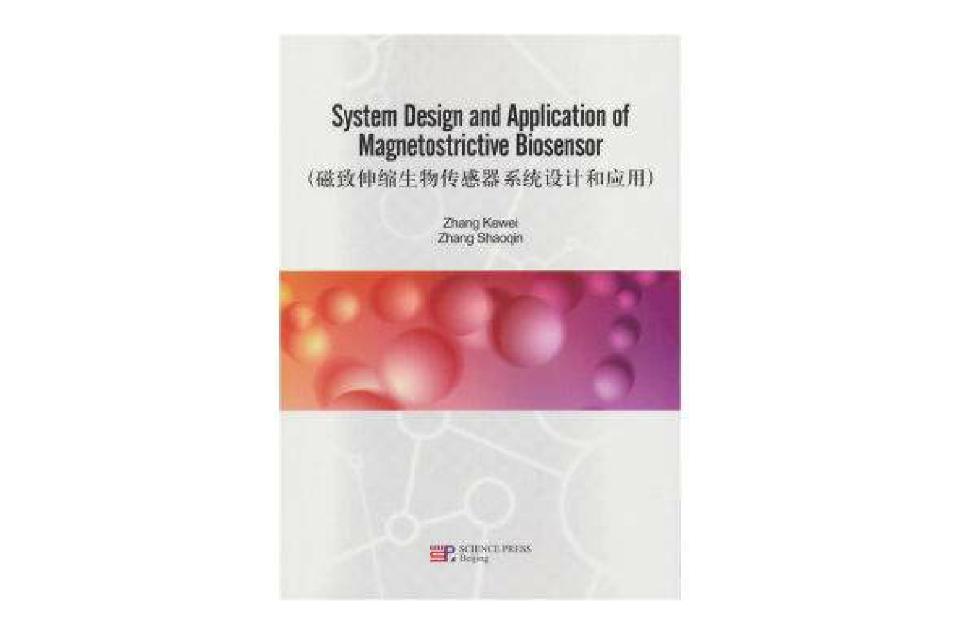《磁致伸縮生物感測器系統設計和套用》是科學出版社有限責任公司2011年10月25日出版的圖書,由張克維、 張少琴編著。
基本介紹
- 書名:磁致伸縮生物感測器系統設計和套用
- 作者:張克維、張少琴
- 原版名稱:System Design and Application of Magnetostrictive Biosensor
- ISBN:9787030325327
- 頁數:138頁
- 出版社:科學出版社有限責任公司
- 出版時間:2011年10月25日
- 裝幀:平裝
- 開本:16
內容簡介,編輯推薦,目錄,
內容簡介
本書系統介紹了磁致伸縮生物感測器系統的設計理論,生產工藝和工程套用以及在現代經濟社會發展中的重要價值。本書共分六個章節,第一章介紹了各類生物感測器技術的優缺點,同時,也介紹了關於食品安全,病原菌,食物傳染疾病,常規微生物檢測方法等方面的基礎知識。第二章介紹了詳細介紹了磁致伸縮納米棒和納米管在生物感測器平台上的套用,介紹了生物感測器平台的關鍵工藝和技術。第三章介紹了磁致伸縮生物感測器在不同介質影響下的諧振回響,並詳細介紹了不同大小的磁致伸縮生物感測器在不同的介質中的頻率回響和Q值特性。第四章介紹了磁致伸縮生物感測器製造技術,同時詳細介紹了固化後的噬菌體或抗原生物感測器在微生物檢測上的套用。第五章介紹了磁致伸縮生物感測器系統的模擬技術和設計原理。詳細介紹了基於頻域的磁致伸縮生物感測器系統和基於時域的磁致伸縮生物感測器系統的特點和套用。第六章介紹了生物感測器的進展和套用展望。本書為一本特色鮮明,在食品安全,生物工程,環境監測,現代醫療檢測技術,物聯網技術以及國防工業等領域有著廣泛的套用和重要的學術研究參考價值.
編輯推薦
Zhang Kewei、Zhang Shaoqin所著的《磁致伸縮生物感測器系統設計和套用》系統介紹了磁致伸縮生物感測器系統的設計理論,生產工藝和工程套用以及在現代經濟社會發展中的重要價值。本書共分六個章節。第一章介紹了各類生物感測器技術的優缺點,同時,也介紹了關於食品安全、病原菌、食物傳染疾病、常規微生物檢測方法等方面的基礎知識。第二章介紹了詳細介紹了磁致伸縮納米棒和納米管在生物感測器平台上的套用,介紹了生物感測器平台的關鍵工藝和技術。第三章介紹了磁致伸縮生物感測器在不同介質影響下的諧振回響,並詳細介紹了不同大小的磁致伸縮生物感測器在不同的介質中的頻率回響和Q值特性。第四章介紹了磁致伸縮生物感測器製造技術,同時詳細介紹了固化後的噬菌體或抗原生物感測器在微生物檢測上的套用。第五章介紹了磁致伸縮生物感測器系統的模擬技術和設計原理,詳細介紹了基於頻域的磁致伸縮生物感測器系統和基於時域的磁致伸縮生物感測器系統的特點和套用。第六章介紹了生物感測器的進展和套用展望。本書為一本特色鮮明,在食品安全、生物工程、環境監測、現代醫療檢測技術、物聯網技術以及國防工業等領域有著廣泛的套用和重要的學術研究參考價值。
目錄
Preface
List of figures
List of tables
List of abbreviations
List Of symbols
1 Introduction
1.1 Introduction to pathogenic bacteria and food-bome illness
1.1.1 Foodbome pathogenic bacteria
1.1.2 Infectious dose and detection of bacteria
1.2 Conventional bacterial detection methods
1.2.1 Plate counting methods
1.2.2 Enzyme-linked immunosorbent assay (ELISA)
1.2.3 Polymerase chain reaction (PCR)
1.3 Biosensors
1.3.1 Optical biosensors
1.3.2 Electrochemical biosensors
1.3.3 Acoustic wave (AW) biosensors
1.3.4 Micro-cantilever (MC) based biosensors
1.3.5 Magnetostrictive micro-cantilever (MSMC)-based biosensors
1.4 Magnetostrictive particle (MSP) based biosensors
1.4.1 Resonance behavior of MSP
1.4.2 Resonance behavior of MSP in visc6us media
1.4.3 Magnetostrictive effect and materials
1.4.4 Current status ofbiosensors based on MSPs
1.5 Sensing element for biosensors--antibodies vs. phages
1.6 Research objectives
References
2 Resonance behavior of msp and influence of surrounding media.
2.1 Introduction
2.2 Characterization of the resonance behavior of an MSP
2.3 Materials and methods
2.4 Results and discussion
2.4.1 Resonance frequency of MSPs
2.4.2 The Qvalue of MSPs
2.4.3 Resonance frequency of MSP in liquid
2.4.4 Determination of surface roughness Rave
2.4.5 Factors that affect the measured surface roughness Rave
2.4.6 Effect of liquid on Q value
2.5 Conclusions
References
3 Techniques in design and production of phage/antibody immobilized
magnetostrictive biosensor for bacterial detection
3.1 Introduction
3.2 MSP preparation
3.3 Phage and antibody immobilization
3.3.1 Phage immobilization
3.3.2 Antibody immobilization
3.4 Blocking agents
3.5 Preparation of bacterial culture
3.6 Experimental setup
3.7 SEM observation
3.8 Hill plot and kinetics of binding
3.9 Results and discussion
3.9.1 Detection of S. typhimurium
3.9.2 Detection of E. coli
3.9.3 Detection of S. aureus
3.9.4 Detection of L. Monocytogenes
3.10 Conclusions
References
4 Design and simulating techniques for portable msp biosensor system
4.1 Introduction
4.2 Equivalent circuit ofmagnetostrictive/magnetoelastic resonator
4.3 Characterization of resonance behavior ofmagnetostrictive/magnetoelastic resonator
4.3.1 Indirect approach for the frequency-domain technique
4.3.2 Time-domain technique
4.4 Conclusions
References
5 Synthesis of amorphous magnetostrictive thin film/nanowires using electrochemical deposition method
5.1 Introduction
5.2 Materials preparation
5.3 Electrochemical deposition of amorphous Co-Fe-B thin films
5.4 Electrochemical deposition of Co-Fe-B nanobars/nanotubes
5.5 Results and discussion
5.6 Conclusions
References
6 Future perspectives and recommendations

